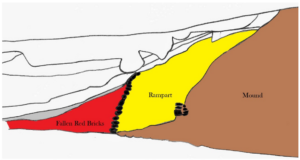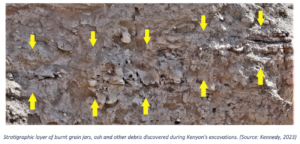A little while ago, I wrote an article and created a list of sites called In His Footsteps: 20 Sites to Visit in the Holy Land. It was a collection of archaeological sites pertaining to Jesus’s time on earth. How fitting, so close to Easter, to be reminded of those special places and to learn about another special site: the city of Jericho.
But before I delve into the biblical and archaeological records of Jericho and its destruction, I need to mention the challenge that I felt this symposium brought to the surface for me.
Have you ever stopped to think about how you approach the Bible? We believe it is the divinely inspired word of God, yes, but do you also give it credit as an accurate record of historical events?
The differences between a myth, a legend, and history
Dr. Titus Kennedy began his symposium Unearthing the Bible with a comparison between myth, legend and history.
The Oxford English Dictionary defines a myth as:
A traditional story, especially one concerning the early history of a people or explaining a natural or social phenomenon, and typically involving supernatural beings or events; a widely held but false belief or idea.
It goes on to explain that a myth is false due to misrepresentation, exaggeration, or it being of a fictitious nature.
Oxford defines a legend as:
A traditional story sometimes popularly regarded as historical but not authenticated.
And the definition of history is:
The study of past events, particularly in human affairs; a continuous, typically chronological, record of important or public events or of a particular trend or institution.
In short, a myth is a false belief, a legend is not authenticated, and history is a record of … events.
| Challenging Question 1: Where do you place the Bible on this spectrum? |
Jericho: the biblical record
The biblical account of the fall of Jericho can be found in Joshua 6. We read that the gates were closed, but that the Lord delivered the city into Joshua’s hands by making the walls collapse such that the army could go up and “straight in”. (Joshua 6:5 NIV)
The Bible also tells us how the house that Rahab lived in and where she hid Joshua’s two spies was part of the city walls (Joshua 2:15) and how, when the walls of Jericho came tumbling down, only Rahab’s family was saved (Joshua 6:23), as promised (Joshua 2:14; Joshua 6:17).
We know that this occurred soon after the harvest (Joshua 3:15) and Joshua 6 tells us how Joshua’s army burned everything in the city (apart from the silver, gold, bronze, and iron) and how Joshua cursed anyone who might consider rebuilding the city.
Jericho: archaeological findings
Excavations of ancient Jericho have been going on at Tell es-Sultan for over a century and some of these have uncovered a stratigraphic layer known as Jericho IVc, which demonstrates collapse of the city walls, destruction of the city by fire, and abandonment of the city.
These excavations have shown that the city was surrounded by a huge wall: the base was a stone retaining wall four to five meters high, with a mud-brick wall on top of it that was two meters thick and six to eight meters high. What’s particularly interesting is that the red bricks of the mud-brick layer were discovered in piles outside of the retaining walls—the upper wall had collapsed outwards to form a ramp of sorts that met the top of the fortification wall.

Another interesting finding was a section of the northern wall that did not collapse along with the rest. The mud-brick upper wall was intact to a height of over two meters and along this stretch stood a few houses. This section of the city was also a short distance away from the Judean wilderness—an easy escape route for spies in hiding.
Finally, what archaeological evidence is there of destruction of Jericho by fire? A one-meter-thick layer of burned ash and debris, along with burnt storage jars that had been full of grain. What’s interesting here, in addition to the evidence of destruction by fire, is the fact that the storage jars were full and that they had not been looted. The former finding is consistent with this occurring soon after the harvest; the latter is inconsistent with military practice at the time, but consistent with the account in Joshua 6. Other armies would have looted this grain as it was a valuable commodity at the time.

Dating Jericho: Garstang vs Kenyon
The collapse of the walls and the destruction of Jericho by fire is not in dispute, but what has led to disagreement amongst archaeologists is dating the Jericho City IVc stratigraphic layer and the timing of these events.
Garstang’s excavations of the 1930s dated Jericho’s destruction to 1400 BC, which is consistent with biblical chronology. Kenyon, however, disputed this based on the absence of a specific type of exotic pottery during her 1950s excavations. But Kenyon didn’t publish her excavation reports themselves; these only became available after her death.
Her reports and those of other archaeologists actually do include pottery of this type, which places Jericho’s destruction in the Late Bronze Age. Add to this the fact that Egyptian scarabs from Pharaoh Amenhotep III, who is estimated to have been born in 1400 BC, were found in this stratigraphic layer of Jericho, and it seems that Garstang’s original dating was correct and supports biblical chronology.
Food for thought
I thoroughly enjoyed learning more about the archaeological excavations of Jericho from Kennedy’s symposium and additional reading, and it is satisfying that archaeology supports the Bible, but here’s a thought:
| Challenging Question 2: Did you need the archaeological evidence to believe the account of the battle of Jericho in the book of Joshua? Should we? |
I’ve certainly been challenged to think about the authority I give God’s word as a historical, not only a spiritual, resource. One final question I’d like to leave you with—one I will be prayerfully mulling over myself over the coming weeks—is:
| Challenging Question 3: How would your reading of the Bible change if you mindfully approached it as the historical record it is? |
- Watch “Unearthing the Bible”, the SATS symposium presented by Dr. Titus Kennedy on the SATS YouTube channel.
- Read Kennedy’s 2023 journal article on the Bronze Age destruction of Jericho.
- Read Wood’s 1999 article, The Walls of Jericho.
- Contact SATS to find out more about biblical lament.
- Read “In His Footsteps: 20 Site to Visit in the Holy Land”.




